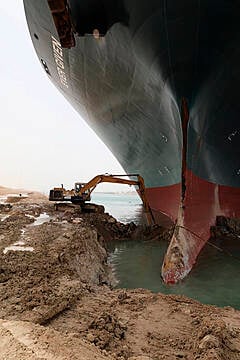A giant container ship remains stuck sideways in Egypt’s Suez Canal for a fifth day as authorities prepare for fresh attempts to free the vessel and reopen the crucial world shipping waterway.
The Ever Given, a Panama-flagged ship that carries cargo between Asia and Europe, ran aground on Tuesday in the narrow canal that runs between Africa and the Sinai Peninsula.
The massive vessel got stuck in a single-lane stretch of the canal, about six kilometres (3.7 miles) north of the southern entrance, near the city of Suez.
Bernhard Schulte Shipmanagement, the technical manager of the Ever Given, said an attempt to free the vessel on Friday had failed.
The maritime solutions provider said plans are in the works to pump water from interior spaces of the vessel, and two more tugs should arrive by Sunday to join others already trying to move the massive ship.
In a press conference on Saturday, lieutenant general Osama Rabie, the head of the canal authority, told reporters that they could not lay out a set timetable for when the ship might be dislodged.
He said he remained hopeful that a dredging operation could free the Ever Given without having to resort to removing its cargo to lighten it.

A maritime traffic jam grew to around 321 vessels near Port Said on the Mediterranean Sea, Port Suez on the Red Sea and in the canal system on Egypt’s Great Bitter Lake, according to Mr Rabei. Egyptian authorities have prohibited media access to the site.
Peter Berdowski, chief executive of Boskalis, the salvage firm hired to extract the Ever Given, said the company hoped to pull the container ship free within days using a combination of heavy tugboats, dredging and high tides.
He told the Dutch current affairs show Nieuwsuur on Friday night that the front of the ship is stuck in sandy clay, but the rear “has not been completely pushed into the clay and that is positive because you can use the rear end to pull it free”.
Mr Berdowski said two large tugboats were on their way to the canal and are expected to arrive over the weekend. He said the company aims to harness the power of the tugs, dredging and tides, which he said are expected to be up to 50cm (20 inches) higher on Saturday.
“The combination of the (tug) boats we will have there, more ground dredged away and the high tide, we hope that will be enough to get the ship free somewhere early next week,” he said.

If that doesn’t work, the company will remove hundreds of containers from the front of the ship to lighten it, effectively lifting the ship to make it easier to pull free, Mr Berdowski added.
A crane was already on its way that can lift the containers off the ship, he said.
The president of Shoei Kisen, the firm which owns the Ever Given, told a news conference at company headquarters in Imabari in western Japan that it had considered removing containers to lighten the vessel if refloating efforts fail, but cautioned that this would be a difficult operation.
The White House has offered to help Egypt reopen the canal, with US president Joe Biden saying: “We have equipment and capacity that most countries don’t have and we’re seeing what we can do and what help we can be.”
An initial investigation showed the vessel ran aground due to strong winds and ruled out mechanical or engine failure, the company and the canal authority said.
Suez vessel breakdown in RGB, via @MarineTraffic pic.twitter.com/X4HoreYv6G
— Sam (@Samir_Madani) March 26, 2021
GAC, a global shipping and logistics company, had previously said the ship had experienced a power blackout, but it did not elaborate.
A prolonged closure of the canal would cause delays in the global shipment chain. Some 19,000 vessels passed through the waterway last year, according to official figures.
About 10% of world trade flows through the canal, which is particularly crucial for transporting oil. The closure could affect oil and gas shipments to Europe from the Middle East.
Some vessels began changing course after the blockage but dozens of ships are still en route to the waterway, according to the data firm Refinitiv.

It remains unclear how long the blockage would last.
Even after reopening the canal that links factories in Asia to consumers in Europe, the waiting containers are likely to arrive at busy ports, forcing them to face additional delays before offloading.







